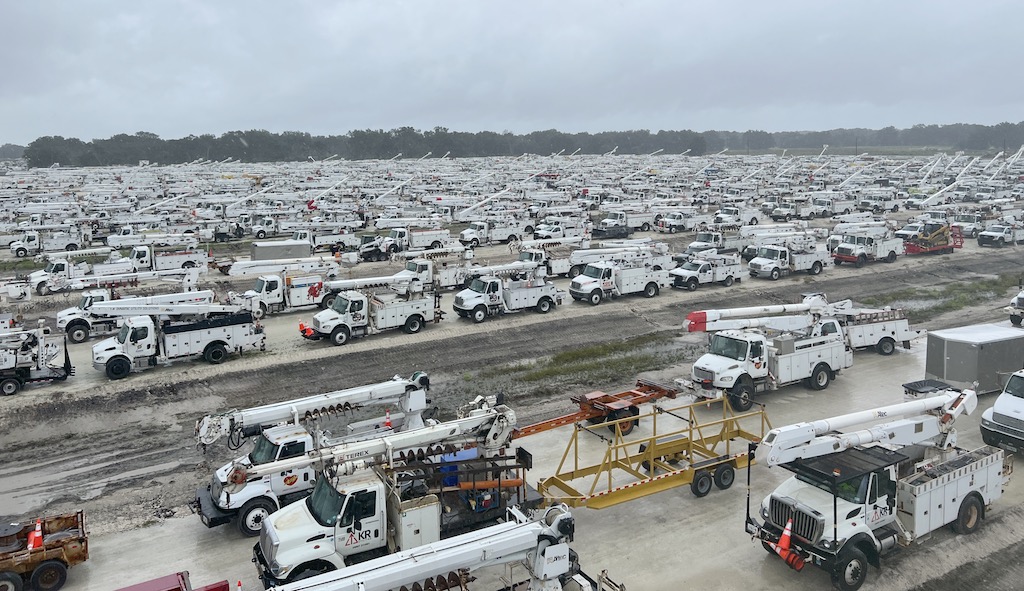From The Christian Science Monitor, October 11:
In the parking lot of a Winn-Dixie, next to emergency shelters and stores with windows blown out by Hurricane Ian, Carl Kingsbury, Allen Wagner, and Joe Kardel spend almost three-fourths of their day in an RV-style command center.
They’ve set two plastic tables in the center of the trailer and littered them with maps, multicolored highlighters, unopened pretzel thins, and a gallon bag of granola bars. On the wall is a diagram of the island’s power grid, color-coded in blue and pink. A generator powers the trailer, AC, and a TV in the background showing football – comfort food.
This is how Pine Island, one of the barrier islands pummeled by Hurricane Ian, gets its power back. Mr. Kingsbury, Mr. Wagner, and Mr. Kardel work for the Lee County Electric Cooperative (LCEC) and are coordinating the restoration work on Pine – only accessible since late last week when the state jury-rigged a new bridge to the island.
Why We Wrote ThisPowerful storms like Hurricane Ian strain the power grids we rely on for everything from homes to schools and traffic lights. In Florida’s case, investments in resilience seem to be paying off.
Two weeks ago, 9 out of 10 homes in Lee County lost power. Since then, more than 91% of the county’s grid is back online, says Mr. Kingsbury, LCEC’s technical training coordinator. An island like Pine, which bore some of Ian’s worst, may have two weeks left before it is entirely back online, and other islands will have to wait longer. But the speed of restoration, matched by other utilities across the state, has been rapid compared with past storms. More than 2 million Floridians lost power two weeks ago. Only about 21,000 are without it now.
Florida spent the past 15 years hardening its electric grid against extreme weather. While a formal analysis will follow, early signs are that it paid off. The state’s utility companies spent a decade and a half swapping wooden poles for concrete and steel ones, undergrounding power lines, and trimming nearby vegetation. This time, most of its citizens got power back within days after a storm that once would’ve disabled the grid for weeks.
No electric system is hurricane-proof – certainly not against a storm that bordered Category 5. And fortifying the grid is a delicate balance of cost and benefit, since citizens have to pay for it in their electric bills or taxes. But as thousands of tree trimmers, repair crews, and other employees like Mr. Kingsbury work 16-to-18-hour days, the state’s investment in its power grid seems to have been good value, says David Dismukes, executive director of Louisiana State University’s Center for Energy Studies.
“I guess some of these resiliency programs are really paying dues right now,” says Professor Dismukes. If taxpayers are left with the bill, he says, “what you want to see is performance outcomes like we did in Florida.”
An impetus named CharleyThe 2004 and 2005 hurricane seasons were disastrous for Florida. About 10 named storms hit the state, including Hurricane Charley, a Category 4 storm that followed a similar path to Ian. Millions of people lost power, some of them for weeks.....
And from the retirement community, The Villages, a look at just how big the mobilization was. Villages-News, September 26:
Duke Energy gathers 10,000 linemen in preparation for Ian’s arrival
Duke Energy has moved 10,000 linemen and support personnel into its 35-county service area which includes part of The Villages, Lake, Sumter and Marion counties.
More than 2,000 trucks with more than 6,000 workers rolled into the 80-acre staging site in The Villages. The site, located on State Road 471 was filled to capacity by 11 a.m. Wednesday. Once the crews had situated their trucks and checked their equipment they were transported by buses to area hotels....

....Many of the linemen and their equipment are from dozens of other companies from across the country – from Michigan, Indiana, Tennessee, Texas and even Ontario, Canada. Though customers might not see a Duke Energy logo on the side of the truck, these workers are here because they responded to Duke’s request for help to restore power to their customers....
....MUCH MORE
I'm not sure why this story wasn't splashed across the front pages of the New York Times, Washington Post, Los Angeles Times et al, it is quite amazing.